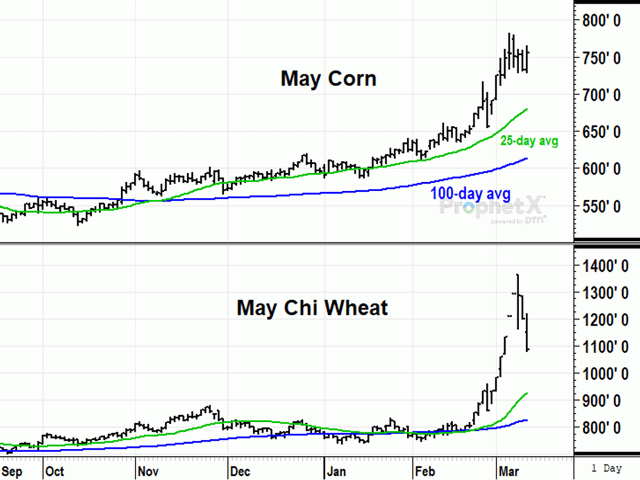Todd's Take
Corn, Wheat Prices Show Different Responses to Events in Ukraine
There are probable events in life and there are improbable events. Ever since the pandemic erupted in early 2020, the improbable events have become more frequent. After the initial pandemic, we saw surprisingly large purchases of corn by China in 2020-21, widespread drought and wildfires in the western United States and Canada and drought in South America in early 2022. Most recently, on Feb. 24, 2022, Russia invaded Ukraine, an unthreatening, largely rural country the World Bank says has a GDP of $3,727 per capita.
As a market analyst trained to look for the most probable outcomes, the recent string of events has been a little like experiencing five 100-year floods in two years. It's been a bit mindboggling to watch as, clearly, markets have been disrupted and, at times, have lost sight of the horizon.
In the grain sector, wheat prices had an explosive reaction to events in Ukraine. Trading near $8.85 a bushel the day before Russia invaded, May Chicago wheat quickly jumped higher and, after closing up-limit in five consecutive sessions, reached a peak of $13.63 1/2 by March 7 evening, 12 days after the attack began.
Not only was wheat up for obvious reasons, related to the fear of losing an important source of world wheat production, Chicago wheat had the added complication of speculators getting caught holding 101,577 contracts short at the time of the invasion. The speculative element added to the buying panic in wheat and made it difficult for shorts to get out.
Just a year ago, on March 15, 2021, the Commodity Futures Trading Commission (CFTC) raised the speculative position limits on several ag commodities, including corn and wheat (see DTN's Market Matters Blog from March 12, 2021, by DTN Basis Analyst Mary Kennedy at https://www.dtnpf.com/….)
P[L1] D[0x0] M[300x250] OOP[F] ADUNIT[] T[]
One of the consequences of increasing speculative participation in the market is that the May contracts have been bid so high, many commercial firms are no longer pricing cash grain off the May contracts and have shifted bids to July. In some cases for wheat, the bids have been shifted to September. In other words, the May futures contracts have diverged so far from reality that they no longer serve the purposes of commercial cash markets.
Speculators can be nervous Nellies in markets they don't understand. Since May wheat hit its March 7 peak of $13.63 1/2, prices have plummeted, ending at $10.87 on March 10. I can't blame speculators for all the uncertainty and price volatility that happens in these unusual situations, but they certainly add to it.
In contrast to wheat, May corn had a volatile couple of days of trading after the invasion began, but has had a more controlled climb upward, going from roughly $6.81 the day before the invasion to $7.55 3/4 on May 10. With May corn now priced roughly 30 cents above the July contract, many commercials have also shifted to July for cash bids, but May corn itself has not shown the same wicked volatility witnessed in Chicago wheat.
At the time of the invasion, speculators were holding 85,156 contracts of corn short, but didn't experience the same squeeze situation we saw in Chicago wheat. The main difference was that in corn, the number of specs long in the market outnumbered shorts by more than 7 to 1, so there was a large pool of specs to help the shorts get out. In Chicago wheat, that was not the case as specs had to buy back contracts largely from commercials. Commercials know their market and weren't so accommodating.
For any would-be traders out there, let me point out the obvious and say that it is inherently foolish for anyone to be on the short side of a futures market when you don't have deliverable supplies to deliver. You are making an expensive promise that you may not be able to keep.
In my book, to be a speculator and to be holding any commodity short in the days leading up to a war that had been warned about for more than two months is the definition of insanity. Maybe we can't stop foolish people from engaging in self-destructive behavior, but the CFTC can certainly rethink its 2021 decision to allow more market-distorting speculators into U.S. ag markets. The world's food supply deserves better.
**
Comments above are for educational purposes only and are not meant as specific trade recommendations. The buying and selling of grain or grain futures or options involve substantial risk and are not suitable for everyone.
Todd Hultman can be reached at Todd.Hultman@dtn.com
Follow him on Twitter @ToddHultman1
(c) Copyright 2022 DTN, LLC. All rights reserved.




